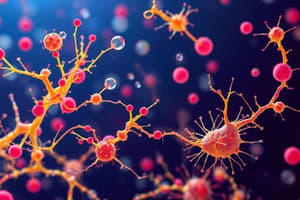Podcast
Questions and Answers
Prokaryotes have a much simpler design than eukaryotes.
Prokaryotes have a much simpler design than eukaryotes.
True (A)
What are the traits of eukaryotic cells?
What are the traits of eukaryotic cells?
- Fungi, Parasites
- Larger than prokaryotes
- Membrane-bound true nucleus
- More than 1 diploid strand
- Membrane-bound organelles
- Bigger ribosomes
- Sterols in membrane
- Cell wall in fungi is chitin
- Respiration via mitochondria
- Sexual/Asexual reproduction
What are the traits of prokaryotic cells?
What are the traits of prokaryotic cells?
- Bacteria
- Smaller than eukaryotes
- No membrane-bound nucleus
- 1 chromosome, haploid circular
- No membrane-bound organelles
- Smaller ribosomes
- No sterols in the membrane
- Peptidoglycan cell wall
- Respiration via cytoplasmic membrane
- Binary fission reproduction
What is the clinical significance of peptidoglycan?
What is the clinical significance of peptidoglycan?
What are the classifications of bacteria?
What are the classifications of bacteria?
What is macroscopic appearance in bacteria?
What is macroscopic appearance in bacteria?
What are the three basic bacterial shapes?
What are the three basic bacterial shapes?
What are the bacterial arrangements?
What are the bacterial arrangements?
What is the purpose of the Gram staining technique?
What is the purpose of the Gram staining technique?
Which organisms cannot be classified by Gram stain?
Which organisms cannot be classified by Gram stain?
What are the steps of Gram staining?
What are the steps of Gram staining?
How does E. coli typically appear visually?
How does E. coli typically appear visually?
How does S. aureus typically appear visually?
How does S. aureus typically appear visually?
What is the clinical significance of Gram staining?
What is the clinical significance of Gram staining?
What are growth/metabolic properties?
What are growth/metabolic properties?
What is antigenicity?
What is antigenicity?
What is serotyping?
What is serotyping?
What are genetic properties in bacteria?
What are genetic properties in bacteria?
In prokaryotes, a mutation in the mother cell may or may not be expressed in daughter cells.
In prokaryotes, a mutation in the mother cell may or may not be expressed in daughter cells.
Where is the round chromosome found in the prokaryotic cell?
Where is the round chromosome found in the prokaryotic cell?
What characterizes the cytoplasmic membrane in prokaryotic cells?
What characterizes the cytoplasmic membrane in prokaryotic cells?
What are the characteristics of the bacterial cell wall?
What are the characteristics of the bacterial cell wall?
What are PAMPs?
What are PAMPs?
Study Notes
Prokaryotes vs. Eukaryotes
- Prokaryotes have a simple design and are generally smaller than eukaryotes.
- Eukaryotic cells include fungi, animals, and plants, characterized by membrane-bound organelles and a true nucleus.
Eukaryotic Traits
- Larger than prokaryotes with complex structures, including multiple diploid chromosomes.
- Membrane-bound organelles present, including mitochondria for respiration.
- Cell walls in fungi contain chitin; capable of sexual and asexual reproduction.
Prokaryotic Traits
- Bacteria that are smaller and simpler than eukaryotic cells.
- Lack a membrane-bound nucleus; possess a single haploid circular chromosome.
- Contain peptidoglycan in their cell walls, crucial for maintaining structure.
Clinical Significance of Peptidoglycan
- Unique to bacterial cell walls, making it an effective target for antibiotics.
Classification of Bacteria
- Based on macroscopic/microscopic appearance, growth/metabolic properties, antigenicity, and genetic properties.
Macroscopic Appearance
- Analyzed through growth characteristics on selective media, which includes colony morphology like size, shape, and sugar fermentation.
Basic Bacterial Shapes
- Cocci: round spheres.
- Bacilli: rod-shaped.
- Spirillum: spiral-shaped.
Bacterial Arrangements
- Cocci and Bacilli arrangements: pairs, chains, or clusters.
- Example of Spirochete includes Borrelia and Treponema.
Gram Staining Technique
- Differentiates bacteria into Gram-positive (purple) and Gram-negative (pink) based on cell wall structure.
Organisms Not Classified by Gram Stain
- Mycobacterium (due to waxy coat).
- Mycoplasma (lacks peptidoglycan).
- Chlamydia (spore-like).
- Treponema (very thin).
Steps of Gram Staining
- Use Crystal Violet (Gram+ turns purple, Gram- absorbs temporarily).
- Iodine is applied to enhance staining.
- Decolorizer (Alcohol/Acetone) removes purple from Gram- bacteria.
- Apply Safranin Red, which stains Gram- pink/red while Gram+ remains purple.
Visual Characteristics
- E.coli: short rods that lightly stain.
- S.aureus: darkly staining clusters of cocci.
Clinical Significance of Gram Staining
- Essential for determining appropriate antibiotic treatment based on bacterial characteristics (e.g., Staphylococcus vs. Streptococcus).
Growth/Metabolic Properties
- Examined through oxygen requirements (aerobic vs. anaerobic), substrate utilization (fermenters vs. non-fermenters), and enzyme production.
Antigenicity
- Defined by the presence of unique surface antigens on bacterial cells.
Serotyping
- Method to distinguish bacterial strains using antibodies that detect specific antigens.
Genetic Properties
- Identified through conserved and variable DNA sequences that aid in classifying bacteria into genus and species.
Prokaryotic Mutations
- Any mutation in a prokaryotic mother cell is always expressed in daughter cells, as they are clones.
Prokaryotic Genetic Material
- Chromosome found in the cytoplasm; no membrane-bound organelles and transcription coupled with translation.
Cytoplasmic Membrane Functions
- Similar to eukaryotes but lacks sterols; involved in electron transport, ATP production, uptake, secretion, and cell division.
Cell Wall Characteristics
- Outermost component in all bacteria except Mycoplasma, critical for structural integrity and preventing osmotic lysis.
PAMPs
- Pathogen-Associated Molecular Patterns trigger innate immune responses due to repetitive structures on bacteria.
Studying That Suits You
Use AI to generate personalized quizzes and flashcards to suit your learning preferences.
Description
This quiz covers the classification and structural differences between prokaryotes and eukaryotes. It includes true/false questions and details about eukaryotic traits, providing a comprehensive overview of microbial biology. Perfect for biology students looking to enhance their understanding of microorganisms.




